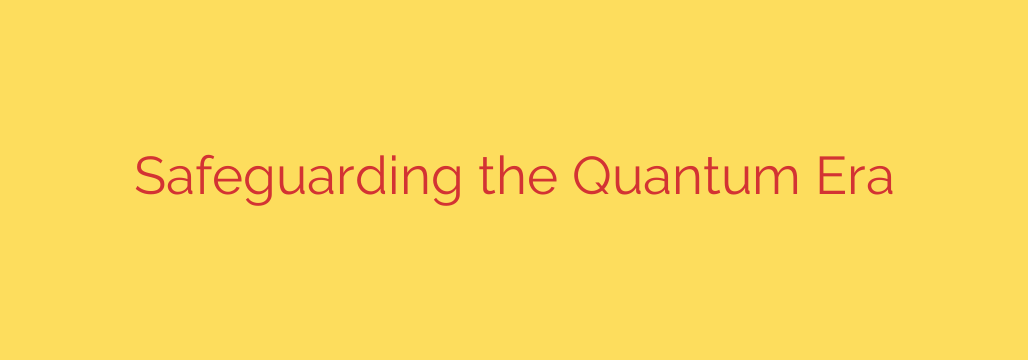
The Quantum Threat Is Coming: How to Secure Your Data in a Post-Quantum World
Quantum computing represents one of the most significant technological leaps of our time. With the power to solve complex problems far beyond the reach of today’s supercomputers, it promises to revolutionize medicine, materials science, and artificial intelligence. However, this immense power comes with a dark side: the ability to shatter the cryptographic foundations that protect our digital world.
The encryption that secures everything from our online banking and private messages to government secrets and corporate data is on a countdown to obsolescence. Understanding this threat—and the steps we must take to counter it—is no longer a futuristic exercise. It’s an urgent security priority for every organization.
The Code-Breaking Power of Quantum Machines
Modern cybersecurity relies on what is known as public-key cryptography. Systems like RSA and Elliptic Curve Cryptography (ECC) are built on mathematical problems that are incredibly difficult for conventional computers to solve. For example, they depend on the near-impossibility of factoring a very large number into its two prime components. A standard computer would take billions of years to break this encryption.
A sufficiently powerful quantum computer, however, could do it in a matter of hours or days.
Using algorithms like Shor’s algorithm, quantum machines can tackle these specific mathematical challenges with ease. This means that quantum computers, once they reach a certain scale and stability, will render most of today’s widely used encryption methods completely insecure. This isn’t a minor vulnerability; it’s a foundational break that would expose the world’s most sensitive data.
The Threat is Here Now: Harvest Now, Decrypt Later
It’s tempting to dismiss the quantum threat as a problem for the distant future. After all, large-scale, fault-tolerant quantum computers don’t exist yet. But this view overlooks a critical and immediate danger known as a “Harvest Now, Decrypt Later” (HNDL) attack.
In an HNDL scenario, adversaries are already stealing and storing massive amounts of encrypted data today. They may not be able to decrypt it now, but they are stockpiling it with the full expectation that they will be able to in the future once a quantum computer is available.
Consider the implications:
- National Security: State secrets, intelligence communications, and military plans could be exposed.
- Intellectual Property: Years of research and development, trade secrets, and proprietary formulas could be stolen.
- Financial Data: Encrypted financial records and transaction details could be compromised.
- Personal Privacy: Private health records, personal communications, and identity information could be laid bare.
Any data encrypted with today’s standards that needs to remain secure for the next decade is already at risk. The HNDL threat makes the quantum transition an urgent issue for right now, not a distant problem for tomorrow.
The Solution: Post-Quantum Cryptography (PQC)
Fortunately, brilliant minds in the cryptographic community have been working on this problem for years. The solution is Post-Quantum Cryptography (PQC), a new generation of cryptographic standards designed to withstand attacks from both classical and quantum computers.
Unlike current standards, PQC algorithms are based on different, more complex mathematical problems that are believed to be difficult for even quantum computers to solve. The National Institute of Standards and Technology (NIST) has been leading a global effort to identify, test, and standardize these next-generation algorithms. After a rigorous, multi-year competition, NIST has selected a suite of PQC algorithms for standardization, providing a clear path forward for organizations to follow.
Post-Quantum Cryptography is the essential defensive measure that will allow us to maintain data security in the quantum era. It is not an upgrade to existing encryption but a full replacement built on a quantum-resistant foundation.
How to Prepare for the Quantum Transition: Actionable Steps
The migration to PQC will be one of the most significant and complex cryptographic transitions in history. It will impact every piece of hardware, software, and digital communication channel. Waiting until the threat is at your doorstep will be too late. Here are the steps your organization should be taking today:
Conduct a Cryptographic Inventory. You cannot protect what you don’t know you have. The first step is to identify all systems, applications, and processes that use public-key cryptography. This includes everything from web servers and VPNs to code-signing certificates and IoT devices.
Embrace Crypto-Agility. Design and update your systems to be “crypto-agile.” This means avoiding hard-coded cryptographic algorithms and instead building architectures that allow you to switch out encryption standards with minimal disruption. This flexibility will be crucial for a smooth transition to PQC.
Develop a Migration Roadmap. Migrating to PQC will not be an overnight project. It will require careful planning, testing, and phased implementation. Start outlining your strategy now, identifying high-priority assets and creating a timeline for upgrading your infrastructure.
Stay Informed and Follow Standards. Keep a close watch on the final standards released by NIST and other international bodies. Partner with vendors who are actively developing and integrating PQC-compliant solutions into their products.
The quantum era is dawning, bringing with it both incredible promise and unprecedented security challenges. While the threat to our current encryption is severe, it is not insurmountable. By understanding the risk, embracing new cryptographic standards, and planning strategically, we can ensure our digital world remains secure.
The transition to a post-quantum world is not a matter of if, but when—and the time to prepare is now.
Source: https://www.paloaltonetworks.com/blog/2025/08/securing-the-quantum-age/








